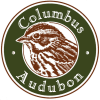We crept up to the edge of the old quarry, looking for waterfowl. Not much beyond a few Scaup, but then we noticed the big white birds on the far side. Swans. But now came the real trick – which species were they? Like a lot of places, we now have 3 swans to choose from, and the marks are not clear-cut (see an article here by David Sibley). If you stop to think about it, they are the most incongruous of waterfowl. No camouflage here; they are huge, and white, and not given to hiding. It’s still hard to believe they can survive in the era of human cities, hunting, and climate change. But they all look alike.
Swans are really just huge geese with long necks. With their huge size, they eschew camouflage, instead producing a white adult plumage that encourages flocking over long distances. They don’t really act shy either, floating out in the open and feeding with their long necks in deep open marshes. We now have 3 flavors of swan in the Midwest: Mute Swans, Tundra Swans, and Trumpeter Swans. Superficially they look alike, but size, head shape, and bill shape and color can be used to safely tell most of them apart. This article from the Dickinson County Conservation Board compares them and adds in their small relative, the Snow Goose. (Dickinson County has lots of swans and geese.)
Tundra Swans Trumpeter Swan Mute Swans
Mute Swans have become our common urban swan, and are the swan equivalent of Starlings. They were introduced in various parts of the northeast by immigrants homesick for the sights of Europe, and have slowly spread over most of the East. They are the swan you see in most urban parks, as well as marshes in Ohio and Michigan over much of the summer. In Michigan, you can find flocks of 20-40 in many large marshes. Nesting Mute Swans are quite aggressive, chasing off most other waterfowl (and the occasional dogs and humans) from the wetlands where they nest. They are thought so dangerous to native waterfowl that many states and Canadian provinces have tried to eradicate them. Washington State and Oregon undertook large scale programs that eliminated most populations in the 2000s.
Tundra Swans are our big migrant swan. They nest on boreal marshes of Canada, and migrate through Ohio on their way to Atlantic coast wintering grounds. Their brassy calls, raining down from high-flying flocks in November and December, are one of the real treats of late fall birding here. They tend to migrate in extended family groups, so large flocks of talkative birds are the norm. As long distance migrants, they are a bit more slender and faster-flapping than the sedentary Mute Swans or lumbering Trumpeter Swans. Old field guides emphasized a yellow lore patch, but that has proven less reliable than body size and bill shape. All over the Midwest, states have re-introduced Trumpeter Swans, so the comparison with Tundras is always subtle and ongoing, as emphasized in this posting from Wisconsin.
Trumpeter Swans are the “new” old kid on the block, so to speak. Fossil middens (ancient refuse dumps) showed bone evidence of them in pre-settlement Ohio, but they disappeared from the Midwest early on. The species was largely restricted to Rocky Mountain wetlands and lakes by the last century. A vigorous re-introduction program by the Ohio Department of Natural Resources (ODNR) has been quite successful in re-establishing them in Ohio, and we now have good numbers of them that nest in the Lake Erie marshes, Killdeer Plains, and Big Island. Many Midwestern and Northeastern states have done similar re-introductions, and have the same swan conundrums we have, as described here for New York. Trumpeters are also huge, bigger than Tundras by almost 50%, and have an unusual beak profile, with a straight “Roman Nose” compared to the other swans. Their relatively soft call, a gentle tooting like toy trumpet, is also distinctive.
Which of them can you see here in central Ohio? Pretty much any of them, depending on the time and location. Mute Swans are our default swan, being present on many of our lakes almost year-round. Tundras are really only seen during migration and occasionally in winter, mostly November through March; look for them on large bodies of water, like reservoirs or the large marshes of Killdeer Plains or Big Island. Trumpeters are more site-specific; they should always be suspected in the wetlands of Killdeer Plains or Big Island, but will also wander to open water lakes in the colder periods of winter. Recently, Trumpeters have established a population at Pickerington Ponds, apparently aided by a cross-fostering experiment where Trumpeter eggs were placed in Mute Swan nests. This made for the awkward scene of large Trumpeter goslings and immatures following around Mute Swan parents.
Our quarry swans were here in winter, so they could’ve been any of the 3 species; they were snoozing and tucked in, and never gave us a good look at their heads. After some debate, they were listed as “swan sp.,” which is sometimes the safest option.







